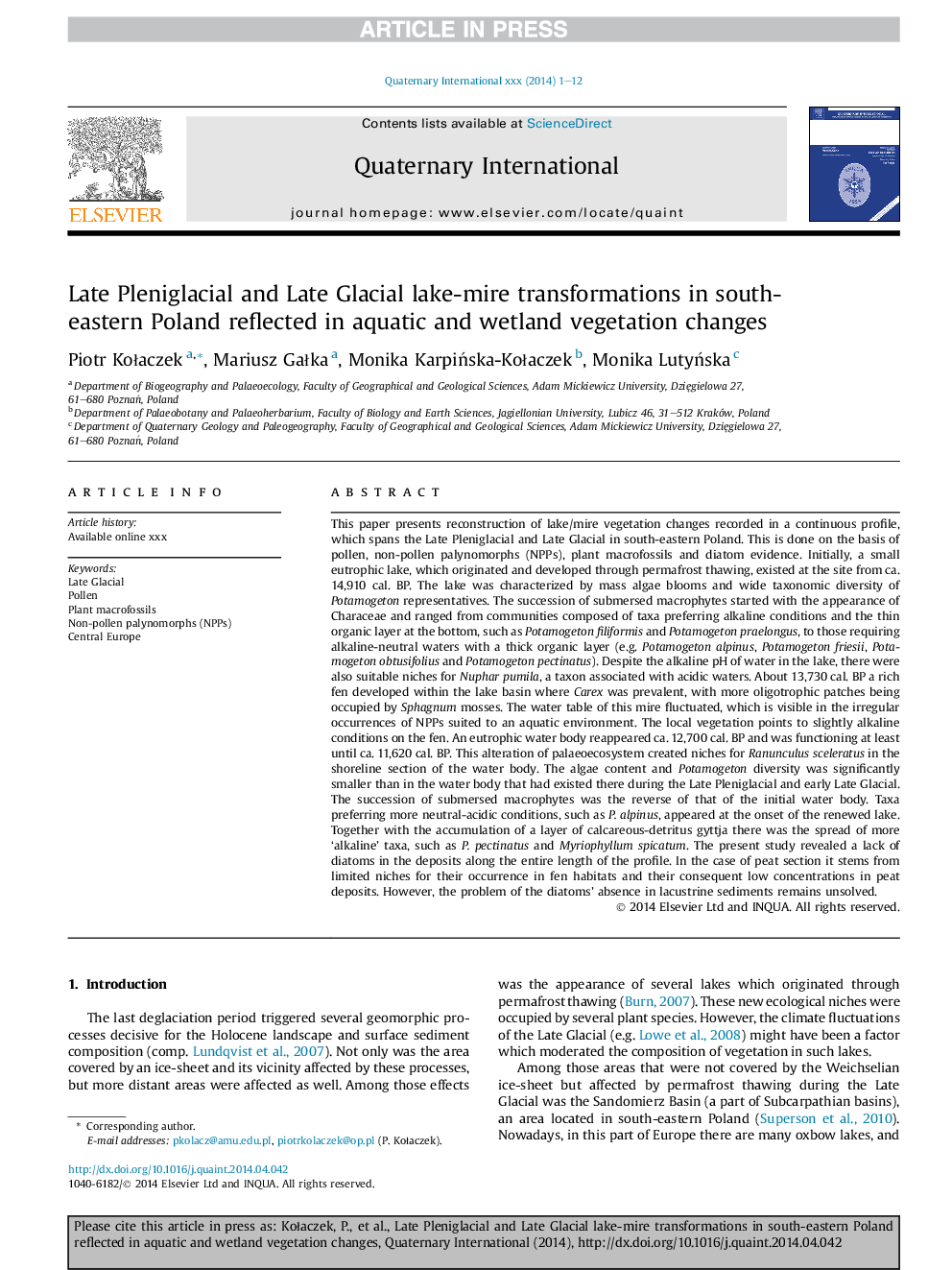| کد مقاله | کد نشریه | سال انتشار | مقاله انگلیسی | نسخه تمام متن |
|---|---|---|---|---|
| 7451402 | 1484110 | 2015 | 12 صفحه PDF | دانلود رایگان |
عنوان انگلیسی مقاله ISI
Late Pleniglacial and Late Glacial lake-mire transformations in south-eastern Poland reflected in aquatic and wetland vegetation changes
ترجمه فارسی عنوان
دگرگونی های خلیج فارس در جنوب شرقی لهستان منعکس شده در تغییرات گیاهی آبزی و تالاب
دانلود مقاله + سفارش ترجمه
دانلود مقاله ISI انگلیسی
رایگان برای ایرانیان
کلمات کلیدی
موضوعات مرتبط
مهندسی و علوم پایه
علوم زمین و سیارات
زمین شناسی
چکیده انگلیسی
This paper presents reconstruction of lake/mire vegetation changes recorded in a continuous profile, which spans the Late Pleniglacial and Late Glacial in south-eastern Poland. This is done on the basis of pollen, non-pollen palynomorphs (NPPs), plant macrofossils and diatom evidence. Initially, a small eutrophic lake, which originated and developed through permafrost thawing, existed at the site from ca. 14,910 cal. BP. The lake was characterized by mass algae blooms and wide taxonomic diversity of Potamogeton representatives. The succession of submersed macrophytes started with the appearance of Characeae and ranged from communities composed of taxa preferring alkaline conditions and the thin organic layer at the bottom, such as Potamogeton filiformis and Potamogeton praelongus, to those requiring alkaline-neutral waters with a thick organic layer (e.g. Potamogeton alpinus, Potamogeton friesii, Potamogeton obtusifolius and Potamogeton pectinatus). Despite the alkaline pH of water in the lake, there were also suitable niches for Nuphar pumila, a taxon associated with acidic waters. About 13,730 cal. BP a rich fen developed within the lake basin where Carex was prevalent, with more oligotrophic patches being occupied by Sphagnum mosses. The water table of this mire fluctuated, which is visible in the irregular occurrences of NPPs suited to an aquatic environment. The local vegetation points to slightly alkaline conditions on the fen. An eutrophic water body reappeared ca. 12,700 cal. BP and was functioning at least until ca. 11,620 cal. BP. This alteration of palaeoecosystem created niches for Ranunculus sceleratus in the shoreline section of the water body. The algae content and Potamogeton diversity was significantly smaller than in the water body that had existed there during the Late Pleniglacial and early Late Glacial. The succession of submersed macrophytes was the reverse of that of the initial water body. Taxa preferring more neutral-acidic conditions, such as P. alpinus, appeared at the onset of the renewed lake. Together with the accumulation of a layer of calcareous-detritus gyttja there was the spread of more 'alkaline' taxa, such as P. pectinatus and Myriophyllum spicatum. The present study revealed a lack of diatoms in the deposits along the entire length of the profile. In the case of peat section it stems from limited niches for their occurrence in fen habitats and their consequent low concentrations in peat deposits. However, the problem of the diatoms' absence in lacustrine sediments remains unsolved.
ناشر
Database: Elsevier - ScienceDirect (ساینس دایرکت)
Journal: Quaternary International - Volume 388, 19 November 2015, Pages 39-50
Journal: Quaternary International - Volume 388, 19 November 2015, Pages 39-50
نویسندگان
Piotr KoÅaczek, Mariusz GaÅka, Monika KarpiÅska-KoÅaczek, Monika LutyÅska,
